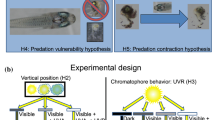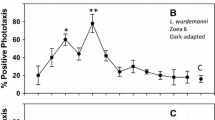Abstract
The ability of young coral reef fishes to feed using solely ultraviolet-A (UV-A) radiation during ontogeny was examined using natural prey in experimental tanks. Larvae and juveniles of three coral reef fish species (Pomacentrus amboinensis, Premnas biaculeatus and Apogon compressus) are able to feed successfully using UV-A radiation alone during the later half of the pelagic larval phase. The minimum UV radiation intensities required for larval feeding occur in the field down to depths of 90–130 m in oceanic waters and 15–20 m in turbid inshore waters. There was no abrupt change in UV sensitivity after settlement, indicating that UV photosensitivity may continue to play a significant role in benthic juveniles on coral reefs. Tests of UV sensitivity in the field using light traps indicate that larval and juvenile stages of 16 coral reef fish families are able to detect and respond photopositively to UV wavelengths. These include representatives from families that are unlikely to possess UV sensitivity as adults due to the UV transmission characteristics of the ocular media. Functional UV sensitivity may be more widespread in young coral reef fishes than in the adults, and may play a significant role in detecting zooplanktonic prey.



Similar content being viewed by others
References
Blaxter JHS (1986) Development of sense organs and behaviour of teleost larvae with special reference to feeding and predator avoidance. Trans Am Fish Soc 115:98–114
Boehlert GW, Watson W, Sun LC (1992) Horizontal and vertical distributions of larval fishes around an isolated oceanic island in the tropical Pacific. Deep Sea Res 39:439–466
Bowmaker JK (1991) The evolution of vertebrate visual pigments and photoreceptors. In: Cronly-Dillon JR, Gregory RL (eds) Evolution of the eye and visual system. Part II, vision and visual dysfunction. CRC, Boca Raton, pp 63–81
Britt LL, Loew ER, McFarland WN (2001) Visual pigments in the early life stages of pacific northwest marine fishes. J Exp Biol 204:2581–2587
Browman HI, Novales Flamarique I, Hawryshyn CW (1994) Ultraviolet photoreception contributes to prey search behaviour in two species of zooplanktivorous fishes. J Exp Biol 186:187–198
Doherty PJ (1987) Light traps: selective but useful devices for quantifying the distributions and abundances of larval fishes. Bull Mar Sci 41:423–431
Douglas RH, Marshall NJ (1999) A review of vertebrate and invertebrate ocular filters. In: Archer SN, Djamgoz MBA, Loew ER, Partridge JC, Vallerga S (eds) Adaptive mechanisms in the ecology of vision. Kluwer Academic Publishers, Boston, pp 95–162
Douglas RH, Bowmaker JK, Kunz YW (1989) Ultraviolet vision in fish. In: Kulikowski JJ, Dickinson RJ, Murray MM (eds) Seeing contour and colour. Pergamon Press, Oxford, pp 601–616
Finn MD, Kingsford MJ (1996) Two-phase recruitment of Apogonids (Pisces) on the GBR. Mar Freshw Res 47:423–432
Frank TM, Widder EA (1996) UV light in the deep-sea: in situ measurements of downwelling irradiance in relation to the visual threshold sensitivity of UV-sensitive crustaceans. In: Lenz PH, Hartline DK, Purcell JE, Macmillan DL (eds) Zooplankton: sensory ecology and physiology. Gordon and Breach Publishers, Amsterdam, pp 185–193
Gerking SD (1994) Feeding ecology of fish. Academic, San Diego
Hawryshyn CW, Moyer HD, Allison TE, Haimberger TJ, McFarland WN (2003) Multidimensional polarization sensitivity in damselfishes. J Comp Physiol A 189:213–220
Helfman GS (1993) Fish behaviour by day, night and twilight. In: Pitcher TJ (ed) Behaviour of teleost fishes, 2nd edn. Chapman and Hall, London, pp 89–128
Houde ED, Zastrow CE (1993) Ecosystem- and taxon-specific dynamic and energetics properties of larval fish assemblages. Bull Mar Sci 53:290–335
Jerlov NG (1976) Marine optics. Elsevier Scientific Publishing Company, New York
Job SD, Bellwood DR (1996) Visual acuity and feeding in larval Premnas biaculeatus. J Fish Biol 48:952–963
Job SD, Bellwood DR (2000) Light sensitivity in larval fishes: implications for vertical zonation in the pelagic zone. Limnol Oceanogr 45:362–371
Job SD, Shand J (2001) Spectral sensitivity of larval and juvenile coral reef fishes: implications for feeding in a variable light environment. Mar Ecol Prog Ser 214:257–277
Job SD, Arvedlund M, Marnane M (1997) Culture of coral reef fishes. Austasia Aquac 11:56–59
Johnsen S (2001) Hidden in plain sight: the ecology and physiology of organismal transparency. Biol Bull 201:301–318
Johnsen S, Widder EA (1998) Transparency and visibility of gelatinous zooplankton from the northwestern Atlantic and Gulf of Mexico. Biol Bull 195:337–348
Johnsen S, Widder EA (2001) Ultraviolet absorption in transparent zooplankton and its implications for depth distribution and visual predation. Mar Biol 138:717–730
Leis JM (1991) Vertical distribution of fish larvae in the GBR lagoon, Australia. Mar Biol 109:157–166
Lesser MP (1995) General overview of instrumentation, experimental methods, and attenuation of UV radiation in natural waters. In: Gulko D, Jokiel PL (eds) Ultraviolet radiation and coral reefs. Sea Grant Publication, Hawaii, pp 15–18
Loew ER, McFarland WN, Mills E, Hunter D (1993) A chromatic action spectrum for planktonic predation by juvenile yellow perch, Perca flavescens. Can J Zool 71:384–386
Loew ER, McAlary FA, McFarland WN (1996) Ultraviolet visual sensitivity in the larvae of two species of marine antherinid fishes. In: Lenz PH, Hartline DK, Purcell JE, Macmillan DL (eds) Zooplankton: sensory ecology and physiology. Gordon and Breach Publishers, Amsterdam, pp 195–209
Losey GS (2003) Crypsis and communication functions of UV-visible coloration in two coral reef damselfish, Dascyllus aruanus and D. reticulatus. Anim Behav 66:299–307
Losey GS, Cronin TW, Goldsmith TH, Hyde D, Marshall NJ, McFarland WN (1999) The UV visual world of fishes: a review. J Fish Biol 54:921–943
Losey GS, McFarland WN, Loew ER, Zamzow JP, Nelson PA, Marshall NJ (2003) Visual biology of Hawaiian coral reef fishes. I. Ocular transmission and visual pigments. Copeia 2003(3):433–454
Lythgoe JN (1988) Light and vision in the aquatic environment. In: Atema J, Fay RR, Popper AN, Tavolga WN (eds) Sensory biology of aquatic animals. Springer, Berlin Heidelberg New York, pp 57–82
Lythgoe JN, Muntz WRA, Partridge JC, Shand J, Williams DMcB (1994) The ecology of the visual pigments of snappers (Lutjanidae) on the Great Barrier Reef. J Comp Physiol A 174:461–468
McFall-Ngai MJ (1990) Crypsis in the pelagic environment. Am Zool 30:175–188
McFarland WN (1991) Light in the sea: the optical world of elasmobranchs. J Exp Zool Supp 5:3–12
McFarland WN, Loew ER (1994) Ultraviolet visual pigments in marine fishes of the family Pomacentridae. Vision Res 34:1393–1396
Nelson PA, Zamzow JP, Erdmann SW, Losey GS (2003) Ontogenetic changes and environmental effects on ocular transmission in four species of coral reef fishes. J Comp Physiol A Neuroethol Sens Neural Behav Physiol 189:391–399
Partridge JC (1990) The colour sensitivity and vision of fishes In: Herring PJ, Campbell AK, Whitfield M, Maddock L (eds) Light and life in the sea. Cambridge University Press, Cambridge, pp 167–184
Pepin P (1991) Effect of temperature and size on development, mortality and survival rates of the pelagic early life history stages of marine fish. Can J Fish Aquat Sci 48:503–518
Shashar N (1995) UV vision by marine animals: mainly questions. In: Gulko D, Jokiel PL (eds) Ultraviolet radiation and coral reefs. Sea Grant Publication, Hawaii, pp 201–206
Siebeck UE (2004) Communication in coral reef fish: the role of ultraviolet colour patterns in damselfish territorial behaviour. Anim Behav 68:273–282
Siebeck UE, Marshall NJ (2000) Transmission of ocular media in labrid fishes. Philos Trans R Soc Lond B 355:1257–1261
Siebeck UE, Marshall NJ (2001) Ocular media transmission of coral reef fish—can coral reef fish see ultraviolet light? Vision Res 41:133–149
Sokal RR, Rohlf FJ (1995) Biometry. Freeman and Co, New York
Stobutzki IC, Bellwood DR (1997) Sustained swimming abilities of the late pelagic stages of coral reef fishes. Mar Ecol Prog Ser 149:35–41
Thorpe A, Douglas RH (1993) Spectral transmission and short-wave absorbing pigments in the fish lens-II. Effects of age. Vision Res 33:301–307
Thorpe A, Douglas RH, Truscott RJW (1993) Spectral transmission and short-wave absorbing pigments in the fish lens-I. Phylogenetic distribution and identity. Vision Res 33:289–300
Tovee MJ (1995) Ultraviolet photoreceptors in the animal kingdom—their distribution and function. Trends Ecol Evol 10:455–460
Wahl CM, Mills EL, McFarland WN, DeGisi JS (1993) Ontogenetic changes in prey selection and visual acuity of the yellow perch, Perca flavescens. Can J Fish Aquat Sci 50:743–749
Zar JH (1999) Biostatistical analysis. Prentice-Hall, New Jersey
Acknowledgments
We thank J. Shand for valuable discussions. R. Rowe, R. Aynsley, R. Fisher and J. Morrison provided invaluable logistical support. Supported by the Australian Coral Reef Society, James Cook University’s Merit Research Grant Scheme and the Australian Research Council. J.C.U. experimental ethics approval no. A402. Publication #164 of the Centre for Coral Reef Biodiversity.
Author information
Authors and Affiliations
Corresponding author
Additional information
Communicated by S. D. Connell, Adelaide.
Rights and permissions
About this article
Cite this article
Job, S., Bellwood, D.R. Ultraviolet photosensitivity and feeding in larval and juvenile coral reef fishes. Mar Biol 151, 495–503 (2007). https://doi.org/10.1007/s00227-006-0482-2
Received:
Accepted:
Published:
Issue Date:
DOI: https://doi.org/10.1007/s00227-006-0482-2




